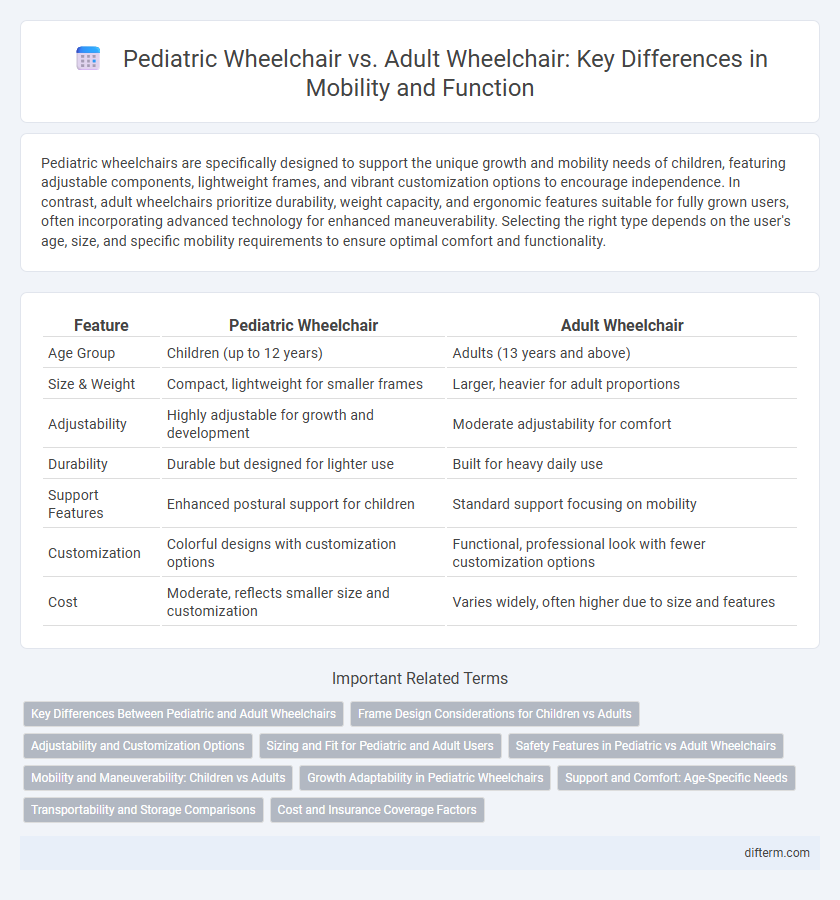Pediatric wheelchairs are specifically designed to support the unique growth and mobility needs of children, featuring adjustable components, lightweight frames, and vibrant customization options to encourage independence. In contrast, adult wheelchairs prioritize durability, weight capacity, and ergonomic features suitable for fully grown users, often incorporating advanced technology for enhanced maneuverability. Selecting the right type depends on the user's age, size, and specific mobility requirements to ensure optimal comfort and functionality.
Table of Comparison
| Feature | Pediatric Wheelchair | Adult Wheelchair |
|---|---|---|
| Age Group | Children (up to 12 years) | Adults (13 years and above) |
| Size & Weight | Compact, lightweight for smaller frames | Larger, heavier for adult proportions |
| Adjustability | Highly adjustable for growth and development | Moderate adjustability for comfort |
| Durability | Durable but designed for lighter use | Built for heavy daily use |
| Support Features | Enhanced postural support for children | Standard support focusing on mobility |
| Customization | Colorful designs with customization options | Functional, professional look with fewer customization options |
| Cost | Moderate, reflects smaller size and customization | Varies widely, often higher due to size and features |
Key Differences Between Pediatric and Adult Wheelchairs
Pediatric wheelchairs are specifically designed to accommodate the unique anatomical and developmental needs of children, featuring smaller frame sizes, adjustable components, and enhanced support for growth and posture. In contrast, adult wheelchairs offer broader size ranges, increased weight capacity, and customization options suited for long-term use and varied adult mobility demands. Both wheelchair types prioritize comfort and functionality but differ significantly in design features to optimize mobility and independence for their respective age groups.
Frame Design Considerations for Children vs Adults
Pediatric wheelchair frames prioritize lightweight materials and adjustable dimensions to accommodate growth and enhance maneuverability in smaller spaces. Adult wheelchair frames emphasize durability and load-bearing capacity, often incorporating reinforced structures to support increased weight and prolonged use. Design considerations for children focus on promoting mobility independence and adaptation over time, whereas adult frames prioritize stability and ergonomic support for longer durations.
Adjustability and Customization Options
Pediatric wheelchairs offer extensive adjustability and customization tailored to the unique growth and developmental needs of children, including adjustable seat depth, height, and support options to promote proper posture and comfort. Adult wheelchairs also provide customization but focus more on accommodating a wider range of body sizes and specific mobility impairments, with options for personalized cushioning, frame configurations, and control mechanisms. The enhanced adaptability in pediatric models ensures ongoing ergonomic support as children grow, differentiating them from typically less modular adult wheelchair designs.
Sizing and Fit for Pediatric and Adult Users
Pediatric wheelchairs are specifically designed with smaller seat widths, depths, and back heights to accommodate the unique body proportions of children, ensuring proper support and comfort during mobility. Adult wheelchairs feature larger dimensions and adjustable components to fit a wide range of adult body sizes and provide optimal posture alignment. Proper sizing and fit in wheelchairs are critical to prevent pressure sores, enhance mobility efficiency, and support long-term musculoskeletal health for both pediatric and adult users.
Safety Features in Pediatric vs Adult Wheelchairs
Pediatric wheelchairs incorporate specialized safety features such as adjustable harness systems, impact-absorbing padding, and enhanced side supports to accommodate children's unique body sizes and growth needs. Adult wheelchairs prioritize robust frame construction, advanced brake mechanisms, and customizable seating to ensure stability and prevent accidents in larger, heavier users. Both designs emphasize safety, but pediatric models focus more on protection tailored to developmental stages and smaller physical dimensions.
Mobility and Maneuverability: Children vs Adults
Pediatric wheelchairs are designed with smaller frames and lighter materials to enhance mobility and maneuverability in confined spaces, accommodating children's developing motor skills. Adult wheelchairs typically offer greater stability and support for long-term use, but their larger dimensions can limit agility in tight environments. Customized adjustments in pediatric models prioritize ease of handling and adaptability to rapid growth, ensuring optimal functional mobility for young users.
Growth Adaptability in Pediatric Wheelchairs
Pediatric wheelchairs are specifically designed with adjustable components such as seat depth, height, and footrest length to accommodate rapid growth and developmental changes in children. These growth adaptability features ensure prolonged usability and comfort, reducing the need for frequent replacements compared to standard adult wheelchairs. Incorporating modular design elements, pediatric wheelchairs support evolving mobility needs while promoting proper posture and physical development.
Support and Comfort: Age-Specific Needs
Pediatric wheelchairs are designed with smaller frames, adjustable supports, and cushioning tailored to growing bodies, ensuring optimal posture and comfort during developmental milestones. Adult wheelchairs offer enhanced weight capacity and customizable seating systems to accommodate prolonged use and varied mobility challenges. Age-specific ergonomic features in both types maximize support, prevent pressure sores, and promote independence for users across different life stages.
Transportability and Storage Comparisons
Pediatric wheelchairs are designed with compact frames and lightweight materials, enhancing transportability for caregivers and making them ideal for tight vehicle spaces. Adult wheelchairs typically feature larger dimensions and heavier weights, which can limit ease of transportation and require more storage space. Folding mechanisms in pediatric models often allow for quicker and more efficient storage compared to some adult wheelchairs with rigid or bulkier designs.
Cost and Insurance Coverage Factors
Pediatric wheelchairs generally incur higher costs due to specialized sizing and customization requirements compared to standard adult wheelchairs, which benefits from larger production scales. Insurance coverage for pediatric wheelchairs often includes more comprehensive provisions due to medical necessity and developmental needs, whereas adult wheelchair coverage may vary significantly depending on policy terms and documentation. Understanding these cost and insurance nuances is crucial for families seeking effective mobility solutions for children.
pediatric wheelchair vs adult wheelchair Infographic

 difterm.com
difterm.com